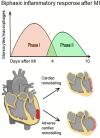In vivo Visualization of M2 Macrophages in the Myocardium After Myocardial Infarction (MI) Using 68 Ga-NOTA-Anti-MMR Nb: Targeting Mannose Receptor (MR, CD206) on M2 Macrophages
- PMID: 35548425
- PMCID: PMC9081970
- DOI: 10.3389/fcvm.2022.889963
In vivo Visualization of M2 Macrophages in the Myocardium After Myocardial Infarction (MI) Using 68 Ga-NOTA-Anti-MMR Nb: Targeting Mannose Receptor (MR, CD206) on M2 Macrophages
Abstract
Introduction and objectives: Wound healing after myocardial infarction (MI) is a dynamic and complex multiple phase process, and a coordinated cellular response is required for proper scar formation. The current paradigm suggests that pro-inflammatory monocytes infiltrate the MI zone during the initial pro-inflammatory phase and differentiate into inflammatory macrophages, and then switch their phenotypes to anti-inflammatory during the reparative phase. Visualization of the reparative phase post-MI is of great interest because it may reveal delayed resolution of inflammation, which in turn predicts adverse cardiac remodeling. Imaging of anti-inflammatory macrophages may also be used to assess therapy approaches aiming to modulate the inflammatory response in order to limit MI size. Reparative macrophages can be distinguished from inflammatory macrophages by the surface marker mannose receptor (MR, CD206). In this study we evaluated the feasibility of 68Ga-NOTA-anti-MMR Nb for imaging of MR on alternatively activated macrophages in murine MI models.
Methods: Wildtype and MR-knockout mice and Wistar rats were subjected to MI via permanent ligation of the left coronary artery. Non-operated or sham-operated animals were used as controls. MR expression kinetics on cardiac macrophages was measured in mice using flow cytometry. PET/CT scans were performed 1 h after intravenous injection of 68Ga-NOTA-anti-MMR Nb. Mice and rats were euthanized and hearts harvested for ex vivo PET/MRI, autoradiography, and staining. As a non-targeting negative control, 68Ga-NOTA-BCII10 was used.
Results: In vivo-PET/CT scans showed focal radioactivity signals in the infarcted myocardium for 68Ga-NOTA-anti-MMR Nb which were confirmed by ex vivo-PET/MRI scans. In autoradiography images, augmented uptake of the tracer was observed in infarcts, as verified by the histochemistry analysis. Immunofluorescence staining demonstrated the presence and co-localization of CD206- and CD68-positive cells, in accordance to infarct zone. No in vivo or ex vivo signal was observed in the animals injected with control Nb or in the sham-operated animals. 68Ga-NOTA-anti-MMR Nb uptake in the infarcts of MR-knockout mice was negligibly low, confirming the specificity of 68Ga-NOTA-anti-MMR Nb to MR.
Conclusion: This exploratory study highlights the potential of 68Ga-NOTA-anti-MMR Nb to image MR-positive macrophages that are known to play a pivotal role in wound healing that follows acute MI.
Keywords: M2 macrophages; PET; inflammation; myocardial infarction; reparative phase.
Copyright © 2022 Varasteh, Braeuer, Mohanta, Steinsiek, Habenicht, Omidvari, Topping, Rischpler, Weber, Sager, Raes, Hernot and Schwaiger.
Conflict of interest statement
The authors declare that the research was conducted in the absence of any commercial or financial relationships that could be construed as a potential conflict of interest.
Figures







Similar articles
-
Targeting mannose receptor expression on macrophages in atherosclerotic plaques of apolipoprotein E-knockout mice using 68Ga-NOTA-anti-MMR nanobody: non-invasive imaging of atherosclerotic plaques.EJNMMI Res. 2019 Jan 21;9(1):5. doi: 10.1186/s13550-019-0474-0. EJNMMI Res. 2019. PMID: 30666513 Free PMC article.
-
Macrophage mannose receptor CD206-targeted PET imaging in experimental acute myocardial infarction.EJNMMI Res. 2025 Jun 4;15(1):66. doi: 10.1186/s13550-025-01254-2. EJNMMI Res. 2025. PMID: 40465093 Free PMC article.
-
Molecular Imaging of Fibroblast Activity After Myocardial Infarction Using a 68Ga-Labeled Fibroblast Activation Protein Inhibitor, FAPI-04.J Nucl Med. 2019 Dec;60(12):1743-1749. doi: 10.2967/jnumed.119.226993. Epub 2019 Aug 12. J Nucl Med. 2019. PMID: 31405922 Free PMC article.
-
Noninvasive Monitoring of Reparative Fibrosis after Myocardial Infarction in Rats Using 68Ga-FAPI-04 PET/CT.Mol Pharm. 2022 Nov 7;19(11):4171-4178. doi: 10.1021/acs.molpharmaceut.2c00551. Epub 2022 Aug 15. Mol Pharm. 2022. PMID: 35969029
-
99mTc-Labeled anti-macrophage mannose receptor (MMR; CD206) nanobody.2012 Sep 4 [updated 2012 Sep 27]. In: Molecular Imaging and Contrast Agent Database (MICAD) [Internet]. Bethesda (MD): National Center for Biotechnology Information (US); 2004–2013. 2012 Sep 4 [updated 2012 Sep 27]. In: Molecular Imaging and Contrast Agent Database (MICAD) [Internet]. Bethesda (MD): National Center for Biotechnology Information (US); 2004–2013. PMID: 23035310 Free Books & Documents. Review.
Cited by
-
Assessment of Squalene-Adenosine Nanoparticles in Two Rodent Models of Cardiac Ischemia-Reperfusion.Pharmaceutics. 2023 Jun 21;15(7):1790. doi: 10.3390/pharmaceutics15071790. Pharmaceutics. 2023. PMID: 37513977 Free PMC article.
-
Control of the post-infarct immune microenvironment through biotherapeutic and biomaterial-based approaches.Drug Deliv Transl Res. 2023 Jul;13(7):1983-2014. doi: 10.1007/s13346-023-01290-2. Epub 2023 Feb 10. Drug Deliv Transl Res. 2023. PMID: 36763330 Free PMC article. Review.
-
Phase I Study of [68Ga]Ga-Anti-CD206-sdAb for PET/CT Assessment of Protumorigenic Macrophage Presence in Solid Tumors (MMR Phase I).J Nucl Med. 2023 Sep;64(9):1378-1384. doi: 10.2967/jnumed.122.264853. Epub 2023 Jul 20. J Nucl Med. 2023. PMID: 37474271 Free PMC article. Clinical Trial.
-
Cardiac macrophages and emerging roles for their metabolism after myocardial infarction.J Clin Invest. 2023 Sep 15;133(18):e171953. doi: 10.1172/JCI171953. J Clin Invest. 2023. PMID: 37712418 Free PMC article. Review.
-
Imaging of tumor-associated macrophage dynamics during immunotherapy using a CD163-specific nanobody-based immunotracer.Proc Natl Acad Sci U S A. 2024 Dec 24;121(52):e2409668121. doi: 10.1073/pnas.2409668121. Epub 2024 Dec 18. Proc Natl Acad Sci U S A. 2024. PMID: 39693339 Free PMC article.
References
-
- Mendis S, Puska P, Norrving B. Global atlas on cardiovascular disease prevention and control. 1st ed. Geneva: World Health Organization in collaboration with the World Heart Federation and the World Stroke Organization; (2011). p. 3–18.
LinkOut - more resources
Full Text Sources
Other Literature Sources
Research Materials

